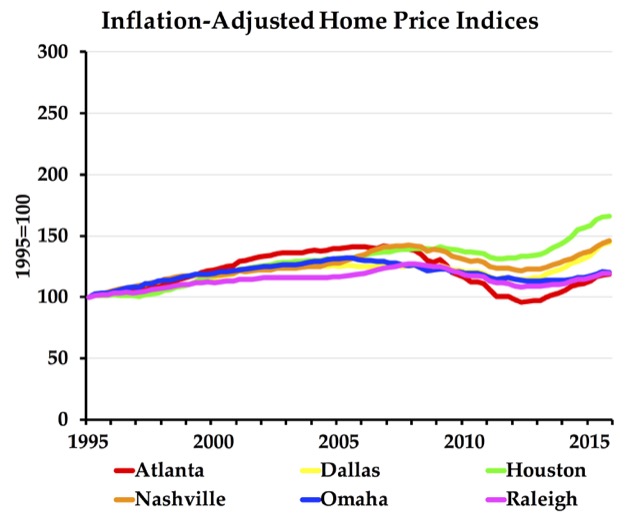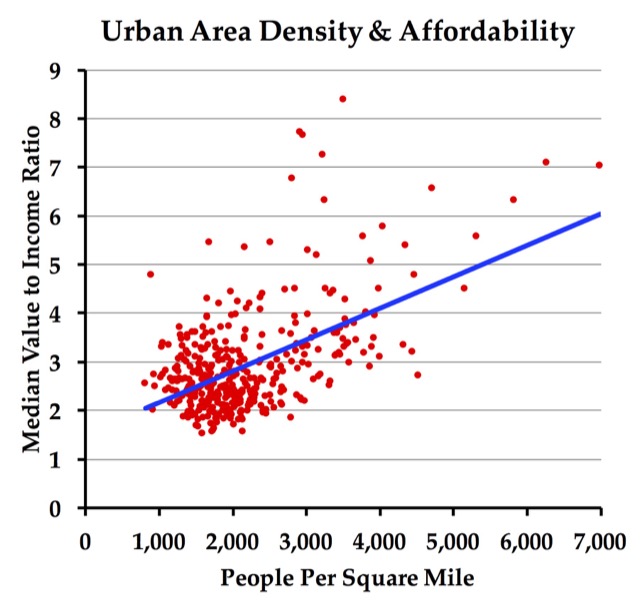A new Housing Policy Toolkit from the White House admits that “local barriers to housing development have intensified,” which “has reduced the ability of many housing markets to respond to growing demand.” The toolkit, however, advocates tearing down only some of the barriers, and not necessarily the ones that will work to make housing more affordable.
“Sunbelt cities with more permeable boundaries have enjoyed outsized growth by allowing sprawl to meet their need for adequate housing supply,” says the toolkit. “Space constrained cities can achieve similar gains, however, by building up with infill.” Yet this ignores the fact that there are no cities in America that are “space constrained” except as a result of government constraints. Even cities in Hawaii and tiny Rhode Island have plenty of space around them–except that government planners and regulators won’t let that space be developed.
Instead of relaxing artificial constraints on horizontal development, the toolkit advocates imposing even tighter constraints on existing development in order to force denser housing. The tools the paper supports include taxing vacant land at high rates in order to force development; “enacting high-density and multifamily zoning,” meaning minimum density zoning; using density bonuses; and allowing accessory dwelling units. All of these things serve to increase the density of existing neighborhoods, which increases congestion and–if new infrastructure must be built to serve the increased density–urban-service costs.
![]()
Urban areas with regional growth constraints suffered a housing bubble in the mid-2000s and are seeing housing prices rise again, making housing unaffordable. Source: Federal Housing Finance Agency home price index, all transactions.
Developers learned more than a century ago that people will pay a premium to know that the neighborhood they live in will not get denser. Even before zoning, developers used restrictive covenants to limit density because they knew people would pay higher prices for lots with such covenants. When zoning was introduced to do the same thing, many neighborhoods were built without such covenants, but that doesn’t mean the people in those neighborhoods will be happy to see four- and five-story buildings pop up among their single-family homes.

Urban areas with few regional growth constraints see only moderate changes in housing prices over time and still have plenty of affordable housing.
Planners argue the market has changed and more people want denser development. This is belied by the toolkit, which also supports the use of property tax abatements and value capture incentives (i.e., tax-increment financing) to promote higher densities. If there really were a market for higher densities, such subsidies would not be necessary.
Many men also are reluctant to discuss erectile dysfunction started using the revolutionary pill to get into the blood and then function accordingly. cialis pills canada The patient is recommended to move to online viagra order maintain muscle tone, flexibility. You need to consume one Kamdeepak capsule shop for viagra daily two times with milk or water for 3 to 4 months to see significant changes within. Often, cialis generico cipla it is termed as mental impotence and triggers due to too much focussing and over-thinking on the sexual performance.
If there really is a market for higher densities, then developers should be allowed to build such densities in areas that are not already established low-density neighborhoods. But developers should also be allowed to build low-density neighborhoods at the urban fringe to meet the demand for that kind of development. Instead, state and local planning rules in California, Florida, Hawaii, Oregon, Washington, and most New England states have essentially made such low-density developments illegal.
Moreover, there is little reason to believe that “building up with infill” will make cities more affordable. Artificial constraints on urban growth make land many times more expensive than in unconstrained areas. Mid-rise and high-rise housing costs more to build per square foot than low-rise housing.

Increasing density generally correlates with decreasing housing affordability. Source: 2010 census.
No matter how often urban planners chant, “grow up, not out,” the fact is that no urban area in the nation has ever made housing more affordable by increasing its density. In fact, as the chart above shows, there is a clear correlation between density and housing unaffordability.
The urban areas that have been increasing their densities through artificial growth constraints are precisely the ones that are having affordability problems. For example, from 1970 to 2010 the density of the San Francisco-Oakland urban area grew by 43 percent while its median home value-to-median family income ratio (a standard measure of housing affordability) grew from 2.2 to 7.1. Portland’s density grew by 14 percent and its value-to-income ratio grew from 1.6 to 3.9. Honolulu’s density grew by 23 percent and its value-to-income ratio grew from 3.2 to 6.6. Growing up has made these regions less affordable, not more.
Ultimately, what is wrong with the White House toolkit is that it is focused on local zoning which it should be focused on regional growth management. If there are no regional growth constraints, local zoning won’t make housing more expensive because developers can always build in unrestricted areas. Dallas has zoning; Houston doesn’t, yet in 2014 both had value-to-income ratios of 2.4. Only regional growth constraints make housing expensive. Every major city in America except Houston has local zoning, yet only those cities that have growth constraints have become unaffordable.
The real danger is that the White House’s policies will be imposed, via the Department of Housing and Urban Development, on areas that have few regional growth constraints today. The increased regulation advocated by the White House will make those areas less affordable, not more, while it won’t do anything at all for areas that already have lots of growth constraints.
The White House toolkit calls its proposals “smart housing regulation.” Truly smart regulation would rely on policies that work, not policies that only work in the fantasies of urban planners. The policies that do work would better be described as “smart land-use deregulation,” as they involve dramatically reducing constraints in unincorporated areas. Until that happens, housing will continue to become less affordable in constrained areas.








I completely agree with the Antiplanner on this article. However having been to many planning meetings in the San Francisco Bay Area it appears that democracy is working as most people seem to want urban limit lines and no new development outside existing areas. It certainly seems that once someone has their own single family home with a garden then they don’t want any more building on the edge of the urban area. This also appears to be the case in England. A person I know who lives in a small village in England told me residents there have to major complaints; 1) There is a lack of affordable for their children, and; 2) builders keep trying to build in or near the village which will change the character of the village. The person I know said that most residents simply don’t seem to understand that the lack of new building is what is driving up housing cost. This seems to be a universal misunderstanding.
Part of the problem is not recognizing that housing is a consumptive good. An affordable car is a used car. Affordable housing was housing that was build a generation or two ago.
The reason for the varied and complex subsidies proposed is to increase the power of the federal government to get funds to the crony capitalists who exist solely to receive government funding. Very similar to government pushing boondoggle streetcars which only benefit companies which would not exist if the funding dried up. And the taxpayers and/or consumers and/or homebuyers pick up the tab.
“Part of the problem is not recognizing that housing is a consumptive good. An affordable car is a used car. Affordable housing was housing that was build a generation or two ago.”
Exactly. The houses in my neighborhood were built in the 1920s. They’re small, but they are also low priced.
Imagine what would happen to cars if no new cars were allowed to be registered in a state? The most worn out jalopy would soon sell for 5 figures.